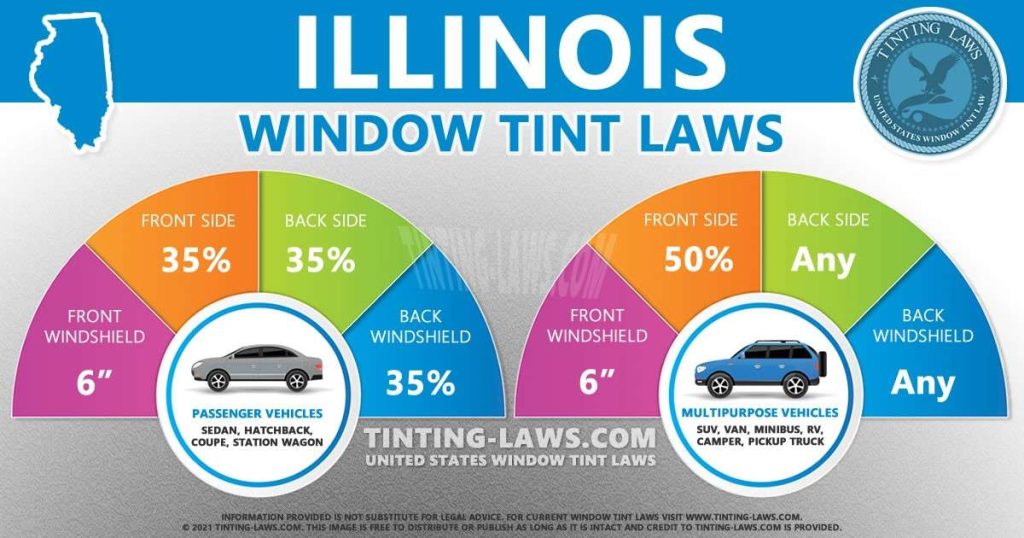Illinois Window Tinting Laws
Car window tinting laws in Illinois were enacted in 2009.
We have provided all the necessary information about your car’s window tint, including how dark or reflective the tint is allowed in your state.
There are also additional car window tinting rules and regulations in Illinois so make sure you read all about it below.
Window tint darkness in Illinois
The percent of visible light allowed through your car windows is called VLT: Visible Light Transmission.
The percentage of light allowed through your film and glass in Illinois is very specific and different for sedan cars and SUV cars or vans.
Tint darkness for sedans:
- Windshield: Non-reflective tint is allowed on the top 6 inches of the windshield.
- Front Side windows: Must allow more than 35% of light in.
- Back Side windows: Must allow more than 35% of light in.
- Rear Window: Must allow more than 35% of light in.
Tint darkness for SUV and vans:
- Windshield: Non-reflective tint is allowed on the top 6 inches of the windshield.
- Front Side windows: Must allow more than 50% of light in.
- Back Side windows: Any darkness can be used.
- Rear Window: Any darkness can be used.
Illinois window tint laws are slightly more complex than most states:
- You can install 35% VLT on all windows (except windshield).
- All windows behind driver can legally have any tint percent, but only if front side windows are not tinted.
- Front side windows may have 50% light transmission, but only if no window behind driver is tinted under 30% VLT.
- On vehicles with factory-installed window tint of any darkness on any back window, front side windows must have over 50% VLT.
Window tint reflection in Illinois
Window tint can reflect incoming light and reduce glare and heat.
Illinois window tint law permits a certain window reflection when using a tint so make sure you pay attention to this as well.
Tint reflection for sedans:
- Front Side windows: Must be non reflective, state law is not specific about what this means.
- Back Side windows: Must be non reflective.
Tint reflection for SUV and vans:
- Front Side windows: Must be non reflective, state law is not specific about what this means.
- Back Side windows: Must be non reflective.
Other Illinois window tint rules and regulations:
Illinois does have several other important laws, rules and regulations pertaining to window tinting. They include the following:
- Side Mirrors: Dual side mirrors are required if back window is tinted.
- Restricted Colors: No colors of tint are explicitly banned by Illinois tint laws.
- Tint Variance: 5% variance.
- Certificates: Manufacturers of film do NOT need to certify the film they sell in the state.
- Stickers: No sticker to identify legal tinting is required.
- Medical Exceptions: Illinois allows medical exemptions for special tint. For more details about the specific terms of the exemption, consult your state law.
- Penalties: Petty offense with $50-$500 fine. Second or subsequent violations are class C misdemeanor with $100 – $500 fine.
Keep in mind that Illinois tinting laws and regulations may be interpreted differently in your county or place of residence.
We always recommend double-checking our information with your local DMV or law enforcement authorities.

Our information about window tint laws in Illinois was last updated in 2024.
Tinting laws in Illinois were enacted in 2009.
In case any of our info provided is not up to date or correct be sure to contact us so we can fix it. Thanks!
Trusted industry leader in providing accurate window tint laws. Share with confidence:
State of Illinois Info
Illinois is a state in the Midwestern United States.
It is the 5th most populous and 25th most extensive state, and is often noted as a microcosm of the entire country.
With Chicago in the northeast, small industrial cities and great agricultural productivity in central and northern Illinois, and natural resources like coal, timber, and petroleum in the south, Illinois has a diverse economic base and is a major transportation hub.

The Port of Chicago connects the state to other global ports from the Great Lakes, via the Saint Lawrence Seaway, to the Atlantic Ocean; as well as the Great Lakes to the Mississippi River, via the Illinois River.
For decades, O’Hare International Airport has been ranked as one of the world’s busiest airports.
Illinois has long had a reputation as a bellwether both in social and cultural terms and politics.
Capital: Springfield
Population: 12,875,255
Area: 57,914 sq mi (149,998 km2)
Cities in Illinois: Chicago, Aurora, Rockford, Joliet, Naperville, Springfield, Peoria, Elgin, Waukegan, Cicero, Champain, Bloomington, Decatur, Arlington Heights, Evanston, Schaumburg, Bolingbrook, Palatine, Skokie, Des Plaines, Orland Park, Tinley Park, Oak Lawn, Berwyn, Mount Prospect, Wheaton, Normal, Hoffman Estates, Oak Park, Downers Grove, Glenview, Belleville, Elmhurst, DeKalb, Moline, Lombard, Buffalo Grove, Urbana, Bartlett, Crystal Lake, Quincy, Streamwood, Carol Stream, Romeovile, Plainfield, Rock Island, Hanover Park, Carpentersville, Wheeling, Park Ridge, Calumet City, Addison, Glendale Heights, Pekin, Northbrook, Elk Grove Village, Danville, St. Charles, Woodridge, North Chicago
Counties in Illinois: Cook, DuPage, Lake, Will, Kane, McHenry, Winnebago, St. Clair, Madison, Champaign, Sangamon, Peoria, McLean, Rock Island, Tazewell, Kendall, LaSalle, Kankakee, Macon, DeKalb, Vermilion, Adams, Williamson, Jackson, Whiteside, Boone, Coles, Ogle, Knox, Henry, Grundy, Macoupin, Stephenson, Franklin, Marion, Livingston, Jefferson, Woodford, Clinton, Fulton, Lee, Morgan, Bureau, Christian, Effingham, Randolph, Monroe, McDonough, Logan, Montgomery, Iroquis, Saline, Jersey, Jo Daviess, Shelby, Perry, Fayette, Douglas, Crawford, Hancock, Edgar, Union, Bond, Warren, Lawrence, Wayne, Piatt, DeWitt, Mercer, Pike, Clark, Richland, Massac, Carroll, Moultrie, Washington, Mason, White, Ford, Greene, Clay, Cass, Menard, Marshall, Johnson, Wabash, Cumberland, Jasper, Hamilton, Alexander, Schuyler, Henderson, Brown, Edwards, Pulaski, Putnam, Stark, Gallatin, Scott, Calhoun, Pope, Hardin
Tint law references:
Illinois Vehicle Code Chapter 12, Article V – Glass, Windshields, and Mirrors
Medical exemption info:
Illinois Tinted Window Medical Certification form (.pdf file)